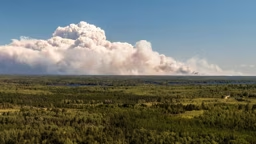Traditionally, we take a long hike across our frozen lake, sled down a friend’s hill until the kids are spent and then hike back.
As our guests tentatively step onto the ice and we begin our journey across, my husband explains how thick the ice is and how safe it is to walk across. I explain to them why I am carrying a safety device called a Frisbuoy. It’s a Frisbee-type device with a long rope attached to it. If someone were to fall through the ice, I could hurl the Frisbuoy toward them while holding on to the end of the rope, then pull them out of the water onto solid ice.
After a few hours at the sledding hill, we decide to head back to the cabin to warm up.
As we hike across the ice, a snowball fight ensues. Within moments adults and children are lobbing snowballs through the air and at one another. Alliances are quickly formed and strategies are devised.
As my husband runs ahead with a group of kids, I suspect they are going to ambush the rest of us just past the now-frozen no-wake zone.
I tip-toe closer to the shore in an effort to sneak around and take them by surprise. A dear family friend motions the remaining guests to join our team. We have but a few more steps to the no-wake zone when I feel my legs give way and I am suddenly – to my complete shock and disbelief – breaking through the ice.
I have a coherent moment and as my legs plunge into the frigid water, I sprawl my upper body out across the ice to catch myself. I am frightened and yell to my husband, “Danny! Danny, help me!”
Time moves in slow motion.
An odd calm comes over me as my husband appears and then moves across the ice. In my heart I believe that I am going to be fine. The water is not too deep and I am close to shore. I’m mostly concerned that someone else could fall through or that the children might be frightened.
Within moments, Danny’s arms reach long across the ice and I feel my arms being pulled from their sockets. My husband – all 6-feet, 4-inches and 240 pounds of him – has extracted me from the ice and is now guiding me slowly and carefully to shore. Everyone is carefully leaving the ice and we are migrating toward land.
I am cold. I am in shock. And I am somewhat embarrassed that everyone was so frightened by the accident they have just witnessed. Miraculously, my boots stayed on, but with every step water sloshes inside them. I am focused on how very cold I feel and how much I want to get back to the cabin. My husband is saying something about a hot shower. I am thinking more of my now-frightened, cold guests and the hot chocolate I want to provide for them.
Later, stripped of my soaked clothing and wearing warm, dry flannel pajamas, I am sitting in front of the fire with family and friends enjoying a steaming mug of hot cocoa. I am finally beginning to feel warm again.
My son points out the irony that I, the one holding on to the Frisbuoy, would fall through the ice. Someone else asks if I’d like the Hasbro game Don’t Break The Ice for a hostess gift.My dear friend recounts that once through the ice, I went into what he refers to as my “typical hostess mode” saying, “It’s okay everybody. Don’t worry. I’m fine. You all keep walking and Danny will help me get out. No worries, kids. We’ll all have hot chocolate and marshmallows back at the cabin.”
We all have a great laugh at my expense. And I don’t pass up this teachable moment to explain why we never go out on the ice alone.
“We were lucky,” I say. “We were truly walking on thin ice.”
Deb Mallin has since returned to the ice where she, her husband and three boys enjoy lots of winter activities. They are the proud owners of three Frisbuoys.
 Deb Mallin
Deb Mallin 









